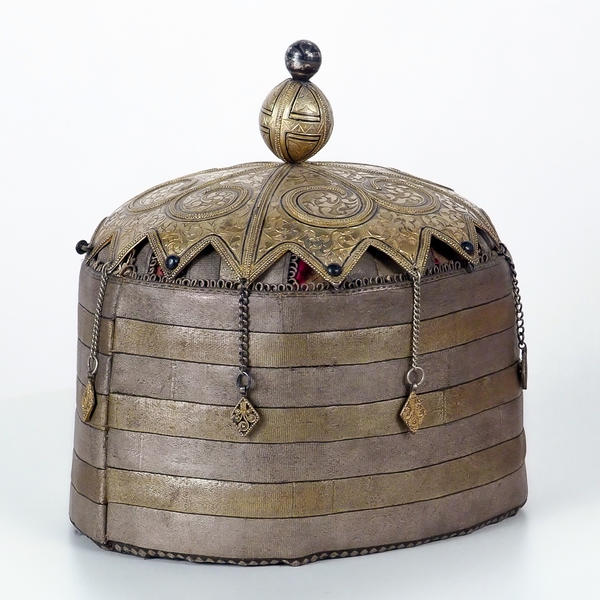Caps of different styles were a traditional headdress of Adyghe girls. The most popular were three types of caps: cone-shaped, small and semi-circular, high with a flat top.
Gallooned cap with silver topper
Creation period
1892
Technique
forge work, chasing, engraving, granulation, niello, gilding (velvet, gold thread, leather, silk, galloon braid)
Exhibition
18
Open in app#3
G. Kadrukova
Gallooned cap with silver topper
#6
#7
The ‘golden cap’ was considered the most elegant. Such a piece of headwear was made of galloon — a figured braid that was woven on special small boards.
Depending on how wide the braid was and how complex the pattern on it should have been, the craftswoman could use from 15 to 95 of such boards. The corners of each of them had several drilled holes, into which were threaded multicoloured threads. They had to be alternated in a strict order to get the correct pattern. The seamstress wrapped the finished trim on a special hook that she fastened to her belt.
Depending on how wide the braid was and how complex the pattern on it should have been, the craftswoman could use from 15 to 95 of such boards. The corners of each of them had several drilled holes, into which were threaded multicoloured threads. They had to be alternated in a strict order to get the correct pattern. The seamstress wrapped the finished trim on a special hook that she fastened to her belt.
#9
It was customary with the Adyghes to decorate ceremonial women’s hats with a silver topper — nachelnik. The nachelnik of the headdress from the museum’s collection is covered with a layer of gilding and decorated with a chased ornament. It is crowned with nielloed, granulated and engraved metal balls, and has short chains with figured pendants descending from the purls along the edge.
#11
Galloon caps were decorated with gold embroidery. This art was taught to girls in noble families from early childhood. It was believed that it helped to cultivate a sense of taste, modesty, obedience and diligence. Adyghe girls also learned to make braids — chains, balls, tassels made of gilded threads. Almost all the handmade items of young craftswomen became the basis of their dowry.
#12
Gold embroidery was an important part of the Adyghe culture. Girls achieved such mastery in it that even foreigners were conquered by their work. Thus, in the 10th century the Arab traveller Al-Mas‘udi wrote:
’. they wear white clothes, Roman brocade, purple, other types of silk fabrics inwrought with gold’. Several centuries later, in the 15th century, the Italian Giorgio Interiano mentioned embroiderers in his book on the life and manners of the Circassians: “their noble women do not do any work, except for embroidering and decorating leather products; they embroider with patterns leather pouches for flints and very beautiful leather sashes as well”.
#13
They decorated with gold and silver embroidery not only the details of women’s costume, but also men’s clothing, quivers for arrows, pouches, saddles. Closer to the 19th century, they began to decorate with such finishes fans, clocks, lamp cases, and other items.
read morehide
00:00
00:00
1x
Gallooned cap with silver topper
Creation period
1892
Technique
forge work, chasing, engraving, granulation, niello, gilding (velvet, gold thread, leather, silk, galloon braid)
Exhibition
18
Open in app
Share


